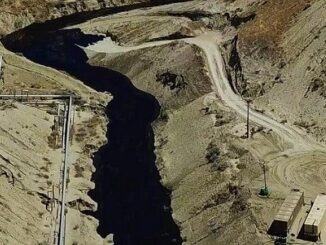
CHEYENNE, Wyoming, February 15, 2021 (ENS) – A settlement has been reached between the U.S. government and the oil and gas company Fleur de Lis Energy, which has agreed to pay $1.9 million for violating the Clean Water Act in Wyoming. The company is headquartered in Dallas, Texas with field operations in Texas and Wyoming.
Enforced by the U.S. Environmental Protection Agency, EPA, the Clean Water Act regulates the quality of surface water across the country and monitors the release of pollutants into the water.
The law prohibits oil discharges into the water that cause any discoloration or shine on the water surface or sludge beneath the water surface.
The Clean Water Act oil pollution prevention requirements were implemented to prevent and to help facilitate responses to dispatched oil from “non-transportation-related onshore facilities,” according to the EPA.
The EPA believes that Fleur de Lis is liable for oil found in Wyoming waters from October 5, 206 to May 29, 2018.

Of the six spills that the EPA is holding Fleur de Lis accountable for, one was in Wyoming’s Johnson County in the Linch Complex Field and the other five were in the Salt Creek Field in Natrona County.
Each of the spills impacted adjoining shoreline and/or caused a sheen on tributaries to Salt Creek, a tributary of the Powder River. The two largest spills were estimated to be 7,307 barrels (306,907 gallons) and 559 barrels (23,478 gallons) of oil.
Fleur de Lis was also alleged to lack Oil Spill Protection, Control, and Countermeasure, SPCC, plans at five of their facilities.
SPCC plans are required for facilities in the United States that have at least 1,320 gallons of oil where there is the possibility that a spill might reach waters of the United States.
Also, the EPA claims that Fleur de Lis did not have any Facility Response Plans at four of their facilities, nor did the company have any facility response training from April 2015 until December 2017.
The planning distance for these four facilities, which represents the extent of potential impacts associated with a worst-case spill scenario, extends over 90 miles to the Powder River.
Facilities such as those of Fleur de lis, which can store more than a million gallons of crude oil, must meet Facility Response Plan requirements because a spill could affect sensitive wildlife and the surrounding environment.
“Companies that store oil must ensure they have adequate spill prevention and discharge response plans to protect public health and the environment,” said Suzanne Bohan, Region 8’s Enforcement and Compliance Assurance Division EPA director. “EPA is committed to ensuring compliance with federal requirements that safeguard our rivers and streams.”
The EPA says that Fleur de Lis has now submitted and implemented its SPCC and FRP plans; is satisfactorily continuing its pipeline maintenance program; and has demonstrated that it can implement its Facility Response Plan and respond to discharges into Salt Creek and the Powder River.
The $1.9 million fee that Fleur de Lis must pay will be deposited into the Oil Spill Liability Trust fund to be used by federal agencies in response to the discharge of oil and other toxic substances into the water.
— By Georgia Seidman
Featured image: Fleur de Lis oil rig in a Wyoming oil field (Photo courtesy Fleur de Lis)
© 2021, Environment News Service. All rights reserved. Content may be quoted only with proper attribution and a direct link to the original article. Full reproduction is prohibited.



